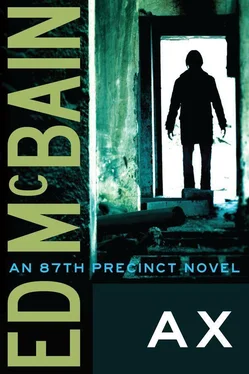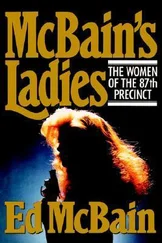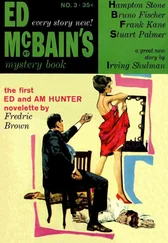An hour later he questioned a bewildered and frightened jeweler named Morris Seigel who had owned a store on Ainsley Avenue for the past twenty years and who had been held up three times a year like clockwork for fifteen out of those twenty. This time the stickup man had come in at 12:30 in the afternoon and stuffed everything he could find into a big canvas bag he was carrying and then, not liking the way Seigel’s head sat on his shoulders, had pistol-whipped him so that Hawes now spoke to a man whose shattered eyeglasses hung askew on his bleeding face, the tears mingling with the blood on his cheeks.
He had gone out on a squeal involving a man who’d fallen onto the subway tracks at Seventeenth and Harris; he had answered a call from the owner of an ice-cream parlor who claimed that someone had ripped his pay telephone out of the booth and run off with it; he had answered three squeals for missing children and one from a man who shouted hysterically, “My wife’s in bed with another man! My wife’s in bed with another man!”
It had been a busy few days.
On Friday morning, January 10, Danny Gimp called and asked to talk to Steve Carella, who was on his way out to investigate, in order, a call from a literary agency where two typewriters had been stolen, a call from a woman who complained of a peeping Tom, and a call from a supermarket manager who believed someone was dipping into the till.
“I think I may have something,” Danny said.
“Can you meet me right now?” Carella asked.
“I’m still in bed.”
“When then?”
“This afternoon.”
“What time?”
“Four,” Danny said. “The corner of Fiftieth and Warren.”
At 9:27 A.M. Carella left the squadroom to begin answering his squeals, hoping he’d be finished by 4:00 in the afternoon. He said goodbye to Hawes who had decided to visit the Lasser family doctor in New Essex and who was on the phone at the moment arguing with Dave Murchison downstairs about the use of a police sedan.
“Hey,” Carella said. “I said goodbye.”
“Okay, I’ll see you later.”
“Let’s hope Danny comes up with something.”
“Let’s hope,” Hawes said, and he waved at Carella as he walked through the gate in the railing, and then he turned his attention back to the phone and began yelling at Murchison again. Murchison wasn’t buying any, thanks. Hawes told him his own car was in the garage with alignment trouble, but Murchison steadfastly maintained that each of the precinct’s sedans was either in use or about to be used that morning, and he couldn’t let Hawes have one even if Hawes brought in the commissioner personally, or perhaps even the mayor. Hawes told him to go to hell. As he was leaving the precinct on the way to the train station, he pointedly walked past the muster desk without saying a word to Murchison. Murchison, busy with the switchboard, didn’t even notice Hawes going by.
Dr. Ferdinand Matthewson was an old man with a leonine mane of white hair, a long nose, and a gentle voice that issued sibilantly from between pursed lips. He wore a dark black suit and he kept his hands, brown with liver spots, tented in front of his face as he sat in a big brown leather chair and watched Hawes intently and suspiciously.
“How long has Mrs. Lasser been ill?” Hawes asked.
“Since 1939,” Matthewson said.
“When in 1939?”
“September.”
“How would you describe her present condition?”
“Paranoid schizophrenia.”
“Do you feel Mrs. Lasser should be institutionalized, sir?”
“Definitely not,” Matthewson said.
“Even though she has been schizophrenic since 1939?”
“She is dangerous neither to herself nor society. There is no reason for her to be institutionalized.”
“Has she ever been institutionalized?”
Matthewson hesitated.
“Doctor?”
“Yes, I heard you.”
“Has she ever been institutionalized?”
“Yes.”
“When?”
“In 1939.”
“For how long?”
Again Matthewson hesitated.
“For how long, sir?”
“Three years.”
“Where?”
“I don’t know.”
“You’re her family physician, aren’t you?” “I am.”
“Then where was she institutionalized? Can you tell me that?”
“I want no part of this, sir,” Matthewson said suddenly. “I want no part of what you’re trying to do.”
“I’m trying to investigate a murder,” Hawes said.
“No, sir. You are trying to send an old woman back into an institution, and I will not help you to do that. No, sir. There has been too much misery in the lives of the Lassers. I will not help you to add to it. No, sir.”
“Dr. Matthewson, I assure you I am—”
“Why must you do this?” Matthewson asked. “Why won’t you let a sick old woman live out her days in peace, cared for and protected by someone who loves her?”
“I’m sorry, Dr. Matthewson. I’d like to let everybody live out his days in peace. But somebody just wouldn’t allow George Lasser to do that.”
“Estelle Lasser didn’t kill her husband, if that’s what you think.”
“No one said she did.”
“Then why do you want to know about her condition? She’s been hopelessly out of her mind since September 1939 when Tony left for—” Matthewson clamped his mouth shut. “Never mind,” he said. “I wish you’d get out of here, sir. I wish you would leave me alone.”
Hawes continued to sit calmly on the other side of Matthewson’s desk. Calmly he said, “Dr. Matthewson, we are investigating a murder.”
“I don’t care what you—”
“We can bring charges against you for impeding the progress of an investigation, but I would prefer not to do that, sir. I’ll tell you simply that it is entirely within the realm of possibility for Mrs. Lasser to have killed her own husband. It is also within the realm of possibility for Anthony Lasser to have—”
“Both of those suppositions are entirely absurd,” Matthewson said.
“If they’re so damn absurd, sir, maybe you’d like to tell me just why.”
“Because Estelle hasn’t been able to recognize her husband or anyone else since that September in 1939. And Tony Lasser hasn’t stepped out of that house on Westerfield Street since he returned home from Virginia in June 1942. That’s why. You are dealing with a delicately constructed symbiosis here, Mr. Hawes, and if you tamper with it, you are liable to destroy two people who have known enough misery in their lives.”
“Tell me about it,” Hawes said.
“I have told you all I care to tell you. I will contribute nothing further to your cause. I ask you in all humility to please, please leave these people alone. They could not possibly have had anything to do with the murder of George Lasser. If you lift this rock, Mr. Hawes, you will find only blind, albino creatures scurrying helplessly from the sun. I beg you not to do that.”
“Thank you, Dr. Matthewson,” Hawes said.
He rose and left the office.
Hawes was not a firm believer in old adages, but there was an old adage that ran to the tune of “Where There’s Smoke, There’s Fire,” and there sure as hell seemed to be a lot of smoke gushing up from Estelle Lasser and her son Tony. The first thing that occurred to Hawes was the possibility that someone had lodged a complaint against Estelle before she’d been institutionalized in 1939, so he ambled over to the New Essex Police Station, introduced himself, and asked to see their records for that year. The New Essex Police, always anxious to cooperate with big city detectives—ha!—happily opened their files to him, and Hawes spent a slow hour and a half perusing the misdemeanors and felonies that had plagued that fair hamlet back in the good old days. Unfortunately Mrs. Lasser had committed neither felony nor misdemeanor; nowhere in the records was there listed any official complaint against her. Hawes thanked the police and walked over to the New Essex Hospital, where he similarly requested a look at their voluminous medical files.
Читать дальше












